|
|
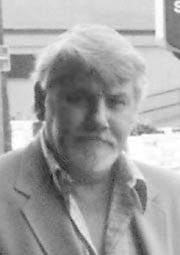
Paul Rivoche took this shot of the artist. Courtesy of & ©2000 Paul Rivoche. A Talk With Alex TothCBA converses with a master of comic book artIn considering the most influential and important comic book artists of all time, Alex Toth's name is never far from the top of anyone's short list—indeed many of today's industry professionals wouldn't hesitate to call him simply the best there ever was. Few artists of his calibre contemplate and study the art form as intensely—and with such obvious love for the form—as our interview subject, as passionate (and often, angry) today as he was as one of the first true comics fans back in the late 1930s and early '40s. CBA had the pleasure of interviewing the artist in his Hollywood home in February 2000 and Alex copyedited the transcript. Comic Book Artist: Is it fair to say that your great desire was to be a syndicated newspaper cartoonist? Alex Toth: Yes. Being a creature of my time, then, the big deal was, "God, I want to be Milton Caniff." I didn't discover Noel Sickles and what he did with strips until long after he'd left Scorchy Smith (for AP Features), and I found him in those little reprint pages in Famous Funnies, five tiers of much-reduced Sickles artwork. [It was] succeeded by Bert Christman, who left the strip after a year or so for a stint at National Periodical Publications (DC) to do "The Three Aces" and "The Sandman," and then left to become one of the first hundred AVG Flying Tiger pilots flying against the Japanese in China and Burma, and then died there in action—all this before Pearl Harbor, mind you! But, yes, it was my dream to do what Caniff, Raymond, and Foster had done, and to be an illustrator as well, because I loved what I saw in the Saturday Evening Post and Liberty, and all the other slick weekly and monthly magazines. CBA: Collier's. Alex: And Collier's. CBA: But you don't regret that you toiled in a different medium? Alex: I do and don't... as Charlie Schulz put it just before he died: "I didn't want to let go, it was taken away from me." Well, that's what happened with strips (and slick magazine illustration, too!). By the time I was "ready," they were already dying, being throttled, squeezed, and distorted, and the whole concept of hero/heroine/ adventure had been tainted, spoiled by the war. Gritty realism had shattered an awful lot of those fantasy dreams. The strip medium had changed. The Big Squeeze was on to force it out, not give it the area and respect it once had. CBA: But you were able to take your love of that and put it into the comic book medium. Alex: Well, it was a wonderful training ground. It was "on-the-job training," is what it was. To be able to (during World War II) when the old-timers were drafted away fighting the war, and left slots open for others to draw these silly things, so I was given a chance, as a kid of 15, still in school. So it was an after school-hours thing for me, which was far better than schlepping wet bulk laundry or dry cleaning or some of the other odd delivery kid jobs I had. It was terrific, the ego thing, to see one's name in print... my God! Who'dathunkit? But then, the appreciation for it came through the material and being paid. But still, a syndicated strip artist had a certain respected position in those days. It was a position of mystery. CBA: Also, Caniff was treated like a movie star. Alex: Well, he was very good at promoting himself, and the Chicago Tribune/New York News Syndicate helped a lot, too. Yes. It helped sell the strip to more papers. 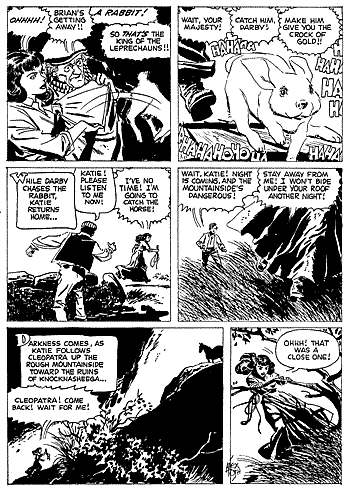 A handsome page from 1959's Four Color #1024, featuring Toth's adaptation of the Disney film, Darby O'Gill and the Little People. ©2000 Walt Disney. CBA: Why wasn't Sickles received the same way? Alex: Well... from all I've heard, AP didn't treat Sickles well. They cheated him when he found out how many papers... and income Scorchy Smith was bringing in, against his $125 a week (I think he finally got it up to that). In the '30s, that was good money! The daily-only strip was earning $1,500 a week! And he just got fed up with it. He might've stayed, had he been treated well, and that would be true for a lot of cartoonists and people, everywhere, in all kinds of jobs. So I missed having that goal, and reaching it, except as a "ghost" or as an assistant—the Warren Tufts thing, which was a few months, here, and there, then a brief stint on Roy Rogers, subbing for Mike Arens when he was ill. CBA: Young comic book cartoonists look at Caniff and Sickles, and don't get it, don't understand it. They think it's antiquated! How can they see what's really there? Alex: Well, they probably won't, until maybe another 10 years of living and seeing: assessing things. Because their heads are filled with the hot artist in comic books, today. They can't see beyond admiring [Jack] Kirby and [Neal] Adams and whoever else was the hotshot 30 years, 20 years, 10 years ago, that's as far back as they go in time, and everybody keeps regurgitating Kirby/Adams! CBA: And Miller. Alex: And Miller... well, that's another story. CBA: And fine art, and photography. Alex: Of course! Yes! CBA: Sickles and Caniff are grouped together so often, can you distill the difference between them? Alex: The younger, Noel Sickles, was the teacher of the older, Milt Caniff. Illustrator/"reporter" is what Sickles was. He didn't exaggerate. He didn't cartoon things. He played it very straight. He was an illustrator! Period! He drew beautifully, had a great eye for perspective, aerial perspective, the whole ball of wax. What he did with figures and lighting and storytelling, the movie techniques he brought into his strip! Black-&-white photography, being 95% of movies in those days, excited him, and he adapted it into his work on Scorchy Smith, using one graytone in his b-&-w art to indicate patterns, light sources showing their effects, in snow scenes, night scenes... remarkable stuff. He was brilliant! Caniff, on the other hand, was more the cartoonist, capable of the bigfoot stuff (although Sickles had that in him, too; both of them much appreciated Roy Crane from the get-go, admired what he could do with simple lines. But, also, that marvelous caricaturist/fantasy artist, T.S. Sullivant). What turned-on Sickles must've turned-on Caniff, re the works of certain artists, cartoonists, painters, because Sickles was keen about impressionists—Monet, Sisley, the political cartoonist David Low, who had lush, wonderful lines and spotting rich blacks, way of drawing and staging! His political cartoons were works of art! Sickles was strongly influenced by Sullivant's distortions, realistic and fantastic, at once. Plus the influence of the Simplicissimus German artist-caricaturist-illustrator Thony and Blix, Gulbransen. He took it all in. Some of it infected Caniff's work, echoes of that influence through Sickles. But Caniff was aware of self-promotion, and how important it would be for a strip, like Terry and the Pirates! I don't know what he may have done to promote Dickie Dare for AP Features, ungenerous with its money or their own promotional material?! But he was helped by deep pockets of the Chicago Tribune/New York News Syndicate, when he got Terry, and they made the most of it. I've got clips from Mini-Cam Photography, a little slick magazine of World War II, and it's spread with lots of photographs of Milt in Chinatown, New York, with his models for the Dragon Lady, Burma, and Pat Ryan. How he took his own photographs with his Rollie twin-lens reflex camera, at his High Torridge home in New City, New York. There was an issue of a fashion magazine, Vogue or Harper's Bazaar, a big spread. Some fashion designer had used Caniff's drawings of evening-gowned women—from his strip, literally—made the gowns for models who looked like his characters! How Caniff drew them, and the gowned photo models! It was great fun! Done with quality, and respect! Caniff—throughout his career—was very adept at self-promotion, with the assistance of the syndicate behind him. But Sickles had other fish to fry, after his experience with AP (with a strip that I'm sure he enjoyed doing), he went off into advertising... of course, that evolved into doing those Mr. Coffee Nerves Sunday page comic ads with Caniff, using their combined alias, "Paul Arthur" (their middle names), and other ad work on his own—halftone, line, color, and he wound up doing ghost work for Caniff on Terry, because Caniff's phlebitis gave him _trouble, perhaps due to malaria (or not) from his Florida days. Sickles was very handy, thank God, to jump in when he did. Caniff had other people on call to assist; Alfred Andriola, Charles Raab, Ray Bailey in his home studio... there was Frank Engli, master letterer and colorist of the Sunday engraver color guides. When Caniff didn't do them! There was a secretary—I forget her name. But anyway, he was well set-up in his home studio. CBA: But of the two, Sickles' work "spoke" to you more, appealed more. Alex: Yes. I always called his work "reportáge," because he had a matter-of-fact way of setting things down, which to me, was damn bare-faced honest. He very rarely pulled tricks, and if he did—and I caught him at it—he'd failed, and when he failed, he failed big. He made it very obvious when he failed, whether it was just a throw-away, or whether he just guessed wrong. CBA: But his batting average was pretty damn good. Alex: Oh, yes, excellent. 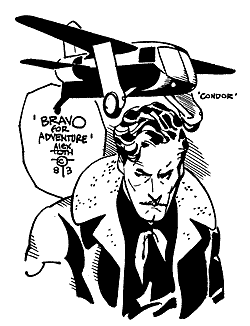 Few concepts are as "pure Toth" as his own Jesse Bravo, a character written, drawn, lettered, and fully-owned by the artist. A fan drawing of the Erroll Flynn-inspired hero, courtesy of John Hitchcock. ©2000 Alex Toth. CBA: In your art, especially the romance work, you were very influenced by what was going on in illustration at the time, Al Parker, Whitmore, John Whitcomb... what excited you about that stuff? Alex: First of all, romance was very special. It dealt with emotions in a different way than the slam-bang adventure stuff. There are a lot of things under the surface... a line of dialogue could say "this," but the expression of the person would say "that." Maybe only the camera/us/the reader's viewpoint would reveal the truth when she said, "I love you, too, George." Her face, eyes were saying something else! And the reader knows that, but "George" doesn't! He can't see that! So, there were all of these little nuances of line readings, acting, reacting, interpretation, layers of character personality, integrity, etc., people bouncing off each other... that was suddenly very grown-up, as opposed to the slam-bang... It was a whole new ballgame, and it forced me to really pay attention, and look, learn and listen. I was lucky to have good scripts. The best romance writing was by Kim Aamodt, really good! I looked for ways to put more into interpreting ping-pong dialogue scenes, the give-and-take between a guy and a gal, or gal and boss, and not reduce it to talking heads. Though a lot of it did wind up being close-ups. I was enjoying characterizations, overdoing it! Not as subtly as I might've. CBA: Well, close-ups in movies were different, a close-up was used for real impact. Alex: Exclamation points, yes. I grew up with radio drama and comedy and movies, with the sounds, colorations, characters. Movies, a once-a-week thing, if that, so radio plus reading, formed my own "pictures" of how characters might look. Our writers' descriptions of scenes were brief, which I liked, and other times, too brief, where I would've appreciated a firmer nudge in the right direction. Emotional drama, as opposed to physical, suddenly was center-stage, and I wanted to do it right. Plus, I enjoyed doing the stylish thing, well-dressed men and women. Inspired by Parker, Whitcomb, plus fashion magazines to bone-up on the latest thing, to smartly dress men and women; it was fun! Plus, Hollywood was the great fashion-setter, movies! Great stars dressed in their best in those smart romantic comedies or dramas of the '30s, '40s, and '50s, before everything went sour. There was a lot more to telling a story, without physical action to lean on, to make it dynamic, to draw the interest of our female readers. Using dramatic tricks, close-ups, poses, and attitudes, expressions, to give the story more punch, without overdoing it. It was great fun, to learn anew. You think you know enough, but you don't. You must open up; let it in. CBA: And learn by doing it. Alex: Yes. To be receptive, admit what you don't know,
which few are willing to do. Start from square one. Again! CBA: Then how come your originals are so clean? There's not a lot of white-out, not lot of heavy erasing. Alex: There came a time when I had to unlearn many things. 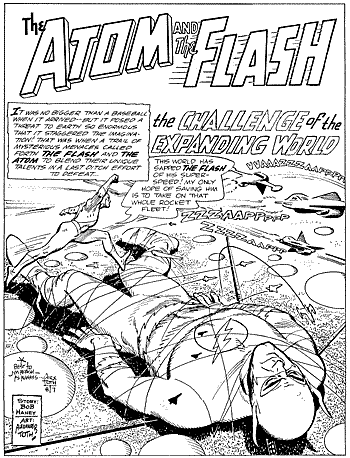 Chances are you might have been first exposed to Alex Toth's artwork in The Brave and the Bold #53 _featuring his (oft-reprinted) story—written by Bob Haney—starring The Atom and The Flash. Courtesy of Jim Amash. ©2000 DC Comics. CBA: You were talking about silhouettes [off-tape]. Alex: First of all, the strongest graphic image you can have. Positive, negative! CBA: The ultimate simplification. Alex: Exactly! The value of it, World War II: We had these images printed everywhere, three-views of German, Japanese aircraft; we had black Bakelite models of these aircraft. Government property, U.S. Army Air Corps, Navy, Marine Corps issue got into the civilian population, so we all knew what German Dornier Bombers looked like, and a Junkers, and Messerschmitt-109s looked like, and a Spitfire, and a Hurricane.... CBA: Just from the outline. Alex: Yes. That's all you needed. CBA: It's the same with characters, everybody has a different... you should be able to tell Superman from Captain Marvel. Alex: The beauty of it, of course, "gag" characters lend themselves to this so much better than straight, with the exception of something like Batman, it can be used in so many dramatic ways, as you see in movies, TV, illustration, and comics. Very effective, to know where and when to use it. To establish depth in a panel, a solid black as a "local color," or drop shadow, establish planes of depth, from foreground to background. To create mysterious effect, hide anything, reveal anything, with it. It's a very potent graphic device. CBA: Another device is color, but you never really colored your own work. Why is that? Alex: The business was not set up that way, then. First of all, I spent my time 3,000 miles away from New York, where the action was. Mailing stuff in and out with my "color notes" all over the margins of my pages. As I could hear dialogue spoken, when I penciled/inked it, or was writing it, to illustrate it. I could hear the way it should be said by the woman, the man, the kid, whatever. So, too, color was important. I wanted to get my two cents in, writing color notes, which, I was told, long after the fact, nobody paid attention to, because they were trimmed off by the engraver for his line shots... The colorists didn't see them. I wanted to do coloring, in spite of the fact I was told I was colorblind... color insensitive. CBA: Are you colorblind? Alex: To light tints of blues, grays and greens, color confusion. CBA: A lot of illustrators and cartoonists are colorblind. Alex: I understand that. CBA: Mort Drucker's colorblind, John Byrne, Chaykin. Alex: Those who work in color all the time, who confess to being colorblind, that's a rarity. CBA: When did you start doing your own lettering? And why? Was it for control? Alex: When I visited dear old Shelly Mayer, a 1,000 years ago, at 225 Lafayette Street, at Gaines Publishing [All-American Comics], he said, "Kid, learn to do it all, to letter. The more you do of your own work and less you rely on somebody else, the better that work is going to be." CBA: Did that include writing? Alex: He didn't stress that, dammit, and I wish he had! I came to writing much too late! And I still can't call what I did "writing." I could not write "on demand," continually! Or I've had been doing it all these years, sitting here, out of the business, because I could not write stories that pleased me! I learned how, but backed into that, my little one-pagers here, two-pagers. CBA: Well, you wrote some of your Warren stories, too. Alex: That came later. 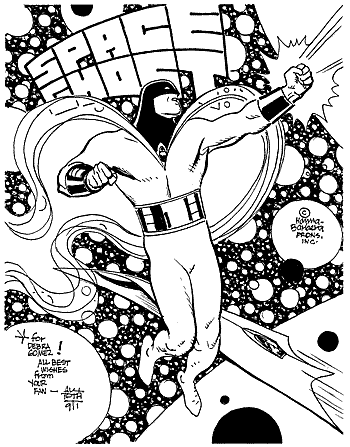 A striking Space Ghost pin-up by Alex. We apologize but we've mislaid the name of the contributor. Please write us with a reminder. Art ©2000 Alex Toth. Space Ghost ©2000 Hanna-Barbera. CBA: Some people think the best comics are written and illustrated by the same person Do you agree? Alex: Exactly. CBA: Really? Alex: Yes. There's something about having that total
vision, control... it sounds very lofty and pretentious; we're
just talking about comic book work here. Charles Schulz sat there,
didn't make a big deal of it, just happened to do it all himself.
Didn't need studio assistants, aides, gag suppliers, it was all
so personal, clear, and clean, all him. CBA: Would you say being an artist is really a solitary life? Alex: It demands a selfishness, a self-orientation of interest—if
you're serious about what you're doing! Some guys in the
business never took it seriously. They could... when the five o'clock
whistle blew, leave the plant like a boilermaker, that's how
much it meant to them, a way of making a buck. I never looked at it
that way. CBA: Did it have a negative effect on your life? Alex: Oh, yes. The more serious I got about it, the more it pulled me away from a wife—marriage, my kids, family, social events—so I don't have a good track record. CBA: You're not a big supporter of painted comics. Alex: No. CBA: And I know why, so we don't need to get into that. Alex: Are you sure you know the reason why? CBA: Yeah, because it's not comics, it's illustration. Alex: No! Wrong! Mainly wrong! It could be comics if those who know how to paint also knew how to tell a story! Who knew what pacing was, and didn't just jam a lot of pretty pictures together into a page, pages, and call it a story, continuity! It ain't! 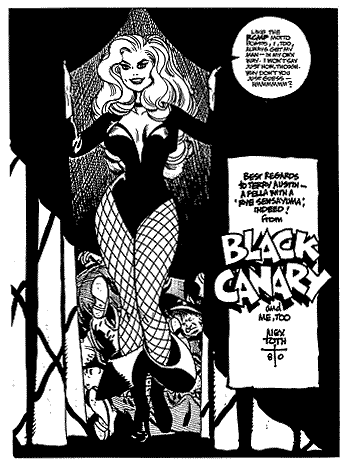 As a gift for inker Terry Austin, Alex rendered this exquisite pin-up of Dinah Lance, the heroine we know as Black Canary. Courtesy of Terry Austin. Art ©2000 Alex Toth. Black Canary ©2000 DC Comics. CBA: What did you think of Harvey Kurtzman? Alex: Brilliant! A "solo act" who, for some reason, needed a troupe behind, under, around him. He would've been best left alone. He should've had a newspaper strip 1,000 years ago. As soon as his Mad thing fell apart, he should've jumped right into a strip, as opposed to the cockamamie years with Hefner, Trump, Humbug, and all other stuff which didn't work. He was deserving of being a very successful newspaper gag cartoonist—whatever he wanted to do, but do it all himself! Not have to deal with "committee-think" and talk and impressing his way on anybody else's. Do it solo. I told him that when we bumped into each other in Vegas, in '70 or '71? Put up as house-guests by University of Nevada Las Vegas personnel in their home. We hadn't talked to each other since that 1952 incident, on that "Sabrejet" job, because I dared to change one or two panels! I told him then, "Harv, I won't be dictated to by you or anyone else! I respected you, and went through the "Dying City" with you, "Thunder-Jet" with you, climbed all over the planes on Republic's production line, made my sketches, took my notes, I was a good boy, for $28 a page (meanwhile getting $40 at DC). I did it out of respect and affection for you, and for the subject matter. I can't make a living or a career out of working over your roughs and layouts, being locked-in so tight, and not being allowed to think, for me, to change this, do that," because everything was already lettered, borders inked in, before you got the pages. It was all done except for the art. "Just pencil in and follow directions." Follow the yellow brick road! CBA: Do you think he squandered a big chunk of his career on "Little Annie Fanny"? Alex: I hated it! Here, you've got this fat magazine, loaded wall-to-wall, with beautiful, nubile women... round, plump, full-bosomed women, fannies, thighs, the works... What the Hell do you need "Little Annie Fanny" for? To me, it was like "gilding the lily," what's the point?! I never understood it. And it became a very complex production problem, I told you about the multiple tissues of vellum overlays, each one color-coded, as it went through the Hefner "editing process," change this, change that... good God Almighty! I would've just tore everything up and thrown it at them, and told them to go to Hell! Either you do it, or I do it, we can't both do it! But that's exactly what Harvey did live with, all those years he was connected. It paid very well, but he had to spend that money, paying Frazetta, Elder... God, everybody in the world helping him do that damn thing. So many people. CBA: You're a big Frank Robbins fan. Alex: I commented on Frank's work in Manuel Auad's Toth book, and also in Comic Book Artist, about being the wrong guy to do The Shadow and Batman. I loved his simpler Scorchy Smith. He shaped-up fast on that strip. He came in knowing nothing about strip technique when he took that over, taught himself, studied everybody—Sickles, his predecessor on that strip, then Bert Christman, then Robert Storm briefly, and then BANG! in came Frank, who stayed with it until '43, '44, left to start his Johnny Hazard for King Features. CBA: You really liked Johnny Hazard? Alex: I liked Scorchy more. CBA: Why? Alex: Because he tightened-up, slicked-up, so much on Hazard... He was loose, fast and loose on Scorchy, and simple. He got very shiny, glitzy, overdoing it to make King happy, to earn his keep. Not necessary! Didn't have to do that. It wasn't until years later, that he relaxed that a bit, but only on his Sunday pages. The daily remained quite "tight." But his last two years on Scorchy Smith were just great. I wish I had a collection of that. There's a Russian sequence he did in those last years, with the Russian and Nazi ski troopers at night, snow scenes, stark black-&-white. He did a helluva job, beautiful stuff, simple, stark, design of the panels, four across, in those days, just great! I had clips of that sequence and lost it in my travels, from East to West and back and could not find a source to get that sequence back again. Gorgeous work in there! Him at his best. Wonderful. It's why he didn't need glitzy schtick, habits formulaic, on Hazard. CBA: You still keep up with the animation world. Alex: I try. CBA: What have you seen that you liked? Iron Giant? Alex: Iron Giant was marvelous, and this Rubén Procopio sent me a copy of Mulan, which I didn't expect to like, but there were a lot of very good parts in it. And I got a print of Pinocchio, which I hadn't seen in many years. I enjoyed that, and 101 Dalmatians animated, which I always liked. CBA: Wallace and Grommit? Alex: Well, that's something else again, totally different. Apples and watermelons. Wonderful, that one... he did three with those characters, but that second one—"The Wrong Trousers"—was absolute perfection! Every frame advanced the story! 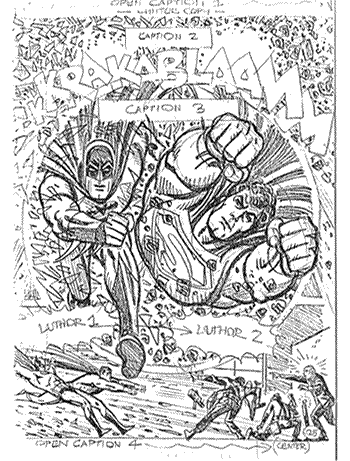 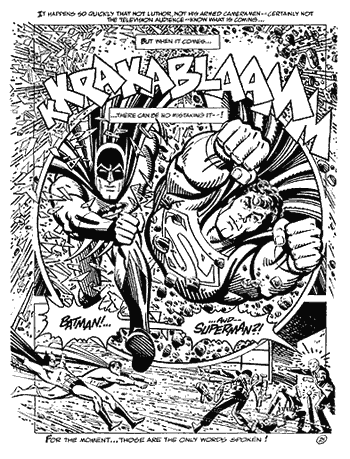 CBA was delighted to receive—from separate sources, no less!—copies of both the Toth-penciled and Terry Austin-inked versions of pages from the 1983 Superman Annual (#9), written by Elliot S! Maggin. Courtesy of David "Hambone" Hamilton and Terry Austin. ©2000 DC Comics. CBA: You did a lot of experimentation with your Warren comics. Why was this period so fertile in that respect? Alex: I liked being asked to do black-&-white comics that the tone would be accepted, whether wash tones or Zip-A-Tones, whatever. I didn't like the horror aspect, the vampires. CBA: Warren is a pretty notorious character.... Alex: I don't know why, because he was decent with me and my late wife, a pretty damn good judge of character—of course, she screwed up with me—but I remember taking her to meet Jim Warren at the Hernando's Hideaway, at the Beverly-Wilshire Hotel, we sat, drank, talked, and kibitzed all night long, at a little table, and was delighted with him, giggled her way through the whole evening, she was a wonderful giggler! If you heard her across the room, you wanted to giggle, too! Anyway, she loved the guy, so that was the seal of approval. We never really bumped heads, he and I, dealing via phone calls and letters, coast-to-coast. He was decent, fair. I don't think I got any special treatment, and I was the auslander, the guy way out here in the boonies of California! I couldn't do anybody any harm, certainly, and I wasn't involved in any internal politics like maybe others, so it was just... fun! CBA: You're a voracious reader. Is it mostly non-fiction, biography? Alex: Mostly, yes. As a kid, I read a lot of science-fiction and comics and pulp magazines, but I got more and more into fact... used to haunt the public library. Bios and autobiographies fascinate—the real deal, real people, real events, themes, different interpretations of them by those involved who write different books about them. I love to read about different disciplines, in the arts, writing, whether it's writing novels, short stories, comic strips, movies, TV, animation. I love to read what writers write about writing. I was a subscriber to Writer's Digest for many years, I loved the magazine and all the tips that all the writers gave to me on how to do it. I can't remember one of them, and I don't think they ever did me any good. As much as I loved the magazine and the tips! And I appreciated them, but I could never put anything to use! I have to do it my own way, my seat-of-the-pants way! My stupid, thick-headed, Hungarian way! There was no formula. I loved all their formula tricks, but I couldn't do it! And then, very late, Neil Simon, confessed that he sits down before a blank page, doesn't know where he's going, has no idea, hasn't pre-planned a thing, no first draft, second draft of anything. He sits and he starts to write, anything, whatever comes into his head, he writes, until something clicks and he's off to the races. From then on, it's easy for him. He "hears" the dialogue, and writes it, bounces from theme to theme. So, he writes without a plan, and that's what Milt Caniff said about Noel Sickles doing Scorchy Smith. He just made it up as he went along, day by day, and his defense was, "Well, if I don't know what the Hell's going to happen tomorrow, how will the reader know? So it'll be more entertaining for both of us!" Caniff said, "You know, there's a thing called three-act play construction, and this is how it's done," and ingrained that into Sickles' head, but in the end, Caniff "script-doctored" for Sickles. CBA: That's how you wrote Jesse Bravo, though, it really flowed. You didn't structure it. Alex: I had written some bits and pieces of Bravo. Didn't have the "full picture," and then, when I sat down, in '75, to do that first 12-page episode, somehow, it all started to work. But as I said, it was bad times, my wife was in and out of the hospital, with three emergency surgeries that year, it was terrible. Every morning, I would spend half my day at the hospital. So, I was stealing sleep time and other time to try to write and draw. I'd start by re-reading what I'd done from page one, right up... If I realized yesterday's work was atrocious, I'd tear it up and start over again from that point. That's the way it went, was backing and filling all the way to the bloody end, 12 pages at a time until done. (This is just a partial excerpt of our Alex Toth coverage in this issue. Be sure to pick up COMIC BOOK ARTIST #11 for the full story!) To make subscription and back issue orders easier for our readers (especially those overseas), we now accept VISA and MASTERCARD on our secure web store! (Phone, fax, mail and e-mail accepted, too!)  Sign up here to receive periodic updates about what's going on in the world of TwoMorrows Publishing. |